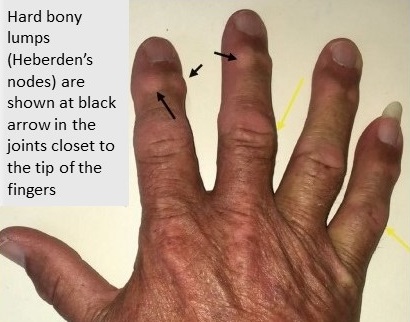By: Rukhsar Jabbar. M.Sc. Physiotherapy. Freelance Health Writer. Medical review by The DLHA Team

A black hand showing bony lumps (Herbeden's nodes) of osteoarthritis at black arrow in joints closets to the tip of the fingers
Osteoarthritis (OA) is a painful condition that affects and damages joints (i.e., where two bones meet). It causes stiffness and limitation in joint movements and it is also associated with swelling, redness and tenderness of soft tissues around an affected joint.
OA is the most common form of arthritis especially in the elderly. Individuals with osteoarthritis typically experience joint discomfort and a brief period of stiffness following rest or inactivity. The joints most frequently afflicted are the knees, hips, neck, hands and the lower back [1].
The purpose of this article is to assist you to better understand osteoarthritis by offering clear, and easy to digest information about the condition, including its symptoms, causes, and management. The article will also provide helpful tips on how to control the pain of osteoarthritis and enhance your quality of life.
OA is a disease that causes changes in the structure and function of joint tissues, including bone spurs (osteophyte production), bone repair (bone remodelling), and breakdown of cartilage (cartilage degradation).
It is a common chronic illnesses especially in the elderly. OA can affect many different aspects of your life, such as mental and physical well-being, mobility, sleep patterns, participation in work, dealing with pain, etc. [2]
What causes the breakdown of joint tissues in primary osteoarthritis is unknown, but as the condition progresses, it can harm every joint component, including:
OA can be classed into two types as follows:
Primary OA has no identifiable underlying cause.
Secondary OA can be due to: [3]
Among the disorders of muscles and bones (musculoskeletal disorders), osteoarthritis is one of the major contributors to years lived with disability.
Osteoarthritis is more common in the elderly (about 70% of those over 55), hence as the population ages, it is anticipated that its prevalence will rise globally.
Osteoarthritis usually develops in the late 40s to mid-50s, although it can occasionally strike younger people, especially athletes and those who have had joint damage or injury as well as those with defective genes in the cartilage of joints [1].
Women make up about 60% of the osteoarthritis population [4] as it often appears after menopause.
The following may raise your odds for osteoarthritis:
Advancing age is the main condition that raises your odds for osteoarthritis (OA). It causes gradual decline in structure and function of your joints.
Post-traumatic osteoarthritis (PTOA) often occurs after severe injuries, like fractures or joint instability, and these can damage the cartilage by increasing stress on the joints.
Obesity, defined as a Body Mass Index (BMI) over 30 kg/m², is a major global health issue. Since walking exerts three to six times more force on the knees, excess weight significantly increases stress on the knee joints, thereby raising the odds for osteoarthritis.
Chronic overuse, genetics, gender, hormone levels, and metabolic disorders also contribute to the development of OA. These factors, along with environmental influences, make OA a complex condition. [5]
The following are typical symptoms of osteoarthritis that you may have: [1]
The joints of the body that are commonly affected by osteoarthritis and the symptoms that you may have include the following: [1]
Published: September 4, 2024
© 2024. Datelinehealth Africa Inc. All rights reserved.
Permission is given to copy, use and share content for non-commercial purposes without alteration or modification and subject to source attribution.
DATELINEHEALTH AFRICA INC., is a digital publisher for informational and educational purposes and does not offer personal medical care and advice. If you have a medical problem needing routine or emergency attention, call your doctor or local emergency services immediately, or visit the nearest emergency room or the nearest hospital. You should consult your professional healthcare provider before starting any nutrition, diet, exercise, fitness, medical or wellness program mentioned or referenced in the DatelinehealthAfrica website. Click here for more disclaimer notice.